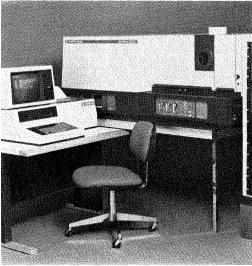|
Instrument Database:
Jarrell-Ash - AtomScan 2000
( Thermo Scientific )
| |
|

|
| |
|
| |
|
| Year of introduction |
1982 |
| Status |
historical ( out of service ) |
| Company |
Jarrell-Ash
|
| Categories |
Spectrometer ( Atom. ): AES: ICP-AES
|
|
Jarrell-Ash’s AtomScan 2000 is a sequential inductively coupled argon plasma (ICAP) spectrometer for methods development and single- or multi-element analyses. The AtomScan 2000 has a highspeed drive which can traverse the entire UV-VIS spectrum in less than s. This feature is a significant advance over existing stepper-motor technology. The AtomScan 2000 scanning monochromator has a 0.75 m crossed Czerny- Turner optical design which covers a wavelength range from 175 to 800 nm. To assure high wavelength accuracy and repeatability, the AtomScan 2000 is microprocessor-calibrated against known wavelengths at frequent intervals during use. Additionally, the instrument is temperature- controlled and air-cushioned for stability. To analyse a variety of solution samples, the AtomScan 2000 uses an ICAP source powered by a 2500W, 27 MHz RF generator. The analyst uses the AtomScan data-acquisition system computer, video monitor and printer--to operate the instrument. Mini-floppy discs contain AtomScan software programs; and menu-driven software leads the analyst step-by-step through instrument operation. A high resolution graphics display format is included for easy interpretation of spectral scans.
|
| Specifications |
|
Dimensions (w x d x h in cm)
| | Weight (kg)
| | Power
|
| Spectrometer
| 0.75 m Czerny-Turner, purged (optional), temperature controlled (+- 0,05 °C); vibrational isolators (air at 80 psig), entrance and exit slit width: 25 µm
| | Grating | 1200 lines/mm, ruled, 75x95 mm, blazed at 400 nm
| Optics
| coated quartz lenes, magnification factor 4, horizontally and vertically adjustable over 25 mm | | Wavelength range | 165-800 nm | Wavelength drive
| high-speed galvanometer drive (165-800 nm in 20 ms) | | Resolution | 18/36 pm respectivelly for the 1st/2nd order
| | Detector | 3 PMT’s (R300,R427, R889)
| Detection mode
| sequential: slew rate up to 120nm/s; step size 9/18 pm, integration time: 100 µs (minimum)
| | Read out | 3 computer controlledA/D converters, multiplexed to a single 12-bit A/D converter (960 readings per second), 107 dynamic range
| | | | ICP generator
| crystal-controlled frequency and automated power control | | Frequency (MHz) | 27.12 | Power (Watt)
| 2500 | Load coil
| autotuning network | Torch
| extended Fassel-type torch
| Argon flow (L/min)
| 15
|
|
| | Sample introduction | cross-flow nebulizer | Operating system and software
| Software written in BASIC including a graphic display (scans), report writing a.0.
| Computer
| Spectrochemical Controller: consisting of two 16 bit microprocessors with up to 64 K RAM and 32 K ROM connected to data acquisition system via serial link; Data processing uses a 6502-based microprocessor with 48 K RAM, 12 K ROM, dual mini-floppy disks (133 K Bytes/disk), green phosphor video monitor, and line printer. | Short term precision (RSD for 10 replicates)
|
| Long term precision (RSD for 4 hours)
|
| Sensitivity
|
| | Detection limits (3s, µg/L) |
| Accessories
|
| Special features
|
|
|
|